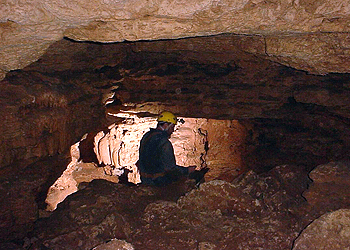Missouri’s caves are legendary, having served as beer storage sites, speak-easies, outlaw hide-outs and the setting for some of Mark Twain’s most memorable scenes.
But a new study shows two centuries of development have eliminated or destroyed many caves in St. Louis County.
“Caves have been discarded by developers with the same impunity as trees,” said Robert E. Criss, Ph.D., professor of earth and planetary sciences in Arts & Sciences and co-author of the study. “Things are developing so rapidly in St. Louis County and elsewhere that we should try a little harder to protect our natural habitat. There is no law in Missouri to protect caves on private land, and we don’t seem to have any protocol as to what is acceptable. The loss of caves is not on anyone’s radar screen, and I think it should be.”

Criss conducted the study with collaborators Jennifer Lippmann, a graduate student in earth and planetary sciences; Everett Criss, Robert Criss’ son; and G.R. Osburn, laboratory administrator in earth and planetary sciences. The study appears as the sole entry in the journal Missouri Speleology (Vol. 45, No. 1, 2007).
The researchers determined the condition of most of the county’s 127 known caves, which are a feature of karst terrain. They found that 24 caves have been lost to or modified by recent development and suburban expansion. That number includes 16 obliterated caves or entrances, three that likely have been destroyed and five that have been turned into culvert entrances.
For example, the entrance to Fogelbach Cave is now a storm sewer culvert in a suburban yard; it is one of several caves managed by the Metropolitan St. Louis Sewer District as part of the sewer system that handles street runoff.
The team used existing data of mostly paper documents, including historic reports and maps between 20-50 years old and some from the late 19th century, to locate the caves. In the historic reports, multiple names or index numbers were sometimes found for the same cave, or the same name and index number were applied to different caves. The researchers updated the records and visited many of the caves, refining the previously reported locations using a global positioning system. Through visits and checking physical features against existing reports, the researchers were able to reach their findings. They entered their reports and all pre-existing reports into the electronic database of the non-profit Missouri Speleological Survey Inc.
The caving experience was not without adventure and astonishment. Early on, Lippmann had a close encounter with a startled animal.
“I was in a tight, watery spot when I suddenly found myself face to face with a beaver,” she said.
Beavers, along with other animals such as raccoons and bears, use caves as temporary domiciles. Caves also are the homes of many species, including several types of bats and salamanders, the Ozark cave crayfish, amphipods and isopods, Criss and Lippmann said.
“Many people do not realize how many caves there are in this area, and yet caving lets you experience a whole different world that is mysterious and beautiful,” Lippmann said.
Yet the authors said caving should be done with proper respect for potential dangers and for preserving these natural features and their inhabitants.
“It’s hard to measure the impact of filling in caves on habitat and species loss,” Criss said. “I’m not saying I want all development to stop or that owners shouldn’t sell to developers. My point is that we really haven’t sufficiently discussed the issue.”
Another karst feature, the sinkhole, is little understood in St. Louis County. In county parks that have not been developed, topographic maps show numerous sinkholes — as many as 100 per square mile. Many other areas, including downtown St. Louis, had similar numbers of sinkholes before development obscured them.
“There are thousands of sinkholes in the county that people are unaware of, as well as maybe 100 more caves that we haven’t yet been able to find,” Criss said.
Along with losing the natural past, development in a karst geological system can affect the future, creating structural and ecological concerns.
“Disregard for springs, caves and sinkholes can lead to their destruction,” the authors wrote, “and can result in engineering problems for structures built on karst terrain.”
To watch a video on this story, visit news-info.wustl.edu/news/page/normal/8793.html.